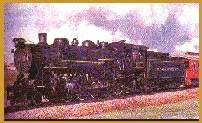-
Trevithick’s Locomotive (1801):
Since roads were not sufficient to meet the needs of transportation,
railroads became necessary. Therefore in 1801, Richard Trevithick
invented the first steam locomotive.
-
Stephenson’s Rocket (1814): George
Stephenson is regarded as ’the father of the railway locomotive’,
because he made great improvements on Trevithick’s locomotive
in his ’Rocket’ in 1814. It moved at a speed of twenty nine
miles an hour.
-
Canals: John Smeaton (1724-1792)
built the Forth and Clyde canals, while Charles Telford constructed
the Ellesmere canal and the Caledonian Canal.
-
Fulton’s Clermont (1807): In 1807,
Robert Fulton invented the steamboat called the ’Clermont’.
It completed the one hundred and fifty five-mile trip on the
River Hudson from New York to Albany, in thirty-two hours, at
a speed of about five miles an hour.
Motive Force
-
Steam Power: Initially manpower
and river water was used as the motive force in order to run
all kinds of machines. However, this proved to be inadequate,
when the new machines were invented. Further water and wind-power
proved to be limited resources. Hence, a new motive force was
sought and discovered in the form of steam power.

Exhibit 8.4
An early steam engine
-
Steam Engine (1705): Thomas Newcomen
invented the first steam engine in 1705, in order to pump water
out of the mines.
-
Watt’s Beelzebub (1769): In 1769,
James Watt invented a better steam engine called the ’Beelzebub.’
This engine was also used to shift spinning and weaving machines
in the textile industries.
-
Electricity: In 1800, Gieseppe Count
Alexandro Volta invented the Voltaic Cell and Michael Faraday
invented the Dynamo. These inventions led to the production
of electric power, which was widely used in industries.
Agriculture
-
Tull’s seed Drill: Jethro Tull (1674-1740)
experimented with farming on a scientific basis. He invented
a Seed Drill that would distribute the seeds evenly in rows,
over a large piece of land.
-
Townsend’s Crop Rotation: The discovery
of a new method of ’Crop Rotation’, was made by Viscount Townsend
(1674-1738). This enabled one to keep land always under cultivation,
without letting it lie idle for a season. This helped to double
the yield per acre.
-
Scientific Breeding of Animals:
Robert Bakewell (1725-1795) introduced scientific breeding of
farm animals. He found through experiments, that by selective
breeding of farm animals, he could improve the quality of cattle,
horses and sheep.
|
Index
8.0 - Introduction
8.1 Meaning
8.2 Features of Industrial Revolution
8.3 Origin of Industrial Revolution
8.4 Course of Industrial Revolution
8.5 Spread of Industrial Revolution
8.6 Consequences of Industrial Revolution
8.7 Dates & Events
8.8 Points to Remember
Chapter 9
|